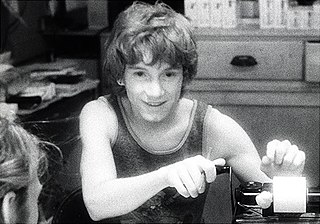Related Research Articles

Leather subculture denotes practices and styles of dress organized around sexual activities that involve leather garments, such as leather jackets, vests, boots, chaps, harnesses, or other items. Wearing leather garments is one way that participants in this culture self-consciously distinguish themselves from mainstream sexual cultures. Many participants associate leather culture with BDSM practices and its many subcultures. For some, black leather clothing is an erotic fashion that expresses heightened masculinity or the appropriation of sexual power; love of motorcycles, motorcycle clubs and independence; and/or engagement in sexual kink or leather fetishism.

Robert Michael Mapplethorpe was an American photographer, best known for his black-and-white photographs. His work featured an array of subjects, including celebrity portraits, male and female nudes, self-portraits, and still-life images. His most controversial works documented and examined the gay male BDSM subculture of New York City in the late 1960s and early 1970s.

Peter Hujar was an American photographer best known for his black-and-white portraits. Hujar's work received only marginal public recognition during his lifetime, but he has since been recognized as a major American photographer of the late 20th century.
Baron George Hoyningen-Huene was a fashion photographer of the 1920s and 1930s. He was born in the Russian Empire to Baltic German and American parents and spent his working life in France, England and the United States.
Eric David Kroll is an American photojournalist, fetish photographer, erotica historian, and book editor.

Jim French was an American artist, illustrator, photographer, filmmaker, and publisher. He is best known for his association with Colt Studio which he, using the pseudonym Rip Colt, created in late 1967. Thomas parted from the endeavor in 1974 leaving French to continue to build what would become one of the most successful gay male erotica companies in the U.S.

Steven Scarborough is an American gay pornographic film director, the founder of Hot House Entertainment (1993), and he was an Executive Vice-President and director for Falcon Studios from 1987 to 1993.
Salvatore Lopes is an American photographer and printer.

Gay pornography is the representation of sexual activity between males. Its primary goal is sexual arousal in its audience. Softcore gay pornography also exists; which at one time constituted the genre, and may be produced as beefcake pornography directed toward heterosexual female, homosexual male and bisexual audiences of any gender.

Daniel Nicoletta is an Italian-American photographer, photojournalist and gay rights activist.
Jack Robinson Jr. was an American photographer and stained glass designer. Robinson was freelance photographer for Vogue and The New York Times from the 1950s to the early 1970s before he left New York to return home to the American South and pursue a career as a stained glass designer.
Michael Stabile III (1974) is an American journalist and documentary filmmaker best known for his work in and about the sex industry. He is the director of Seed Money, a documentary about pioneering gay porn producer Chuck Holmes, of Falcon Studios. Stabile's written work on sex and sexuality has appeared in Playboy, The Daily Beast, BuzzFeed, and New York Times, among others.

Philip Gefter is an American author and photography historian. His books include Cocktails with George and Martha: Movies, Marriage, and the Making of Who's Afraid of Virginia Woolf?; What Becomes A Legend Most, the biography of Richard Avedon; and Wagstaff: Before and After Mapplethorpe, the biography of Sam Wagstaff, for which he received the 2014 Marfield Prize, the national award for arts writing. He is also the author of George Dureau: The Photographs, and Photography After Frank, a book of essays published by Aperture in 2009. He was on staff at The New York Times for over fifteen years, where he wrote regularly about photography. He produced the 2011 documentary film, Bill Cunningham New York.

John Joseph "Jack" Fritscher is an American author, university professor, historian, and social activist known internationally for his fiction, erotica, and nonfiction analyses of pop culture and gay male culture. An activist prior to the Stonewall riots, he was an out and founding member of the Journal of Popular Culture. Fritscher became highly influential as editor of Drummer magazine.
Nights in Black Leather is a 1973 gay pornographic film directed and co-produced by Richard Abel under the pseudonym Ignatio Rutkowski for Jaguar Studios, Abel was also responsible for cinematography, editing and music. The film's original title was Post Haste Hustle, but was changed by the distributor to Nights in Black Leather.
That Boy is a 1974 gay pornographic film written, produced and directed by Peter Berlin, his first and only feature-length pornographic film. It is also the second and last feature-length porn film in which he appeared as an actor following the huge success of Nights in Black Leather (1973). Although he is credited as director, producer and actor under the name Peter Burian, following the threat of a lawsuit from another actor named Peter Burian he changed his name to Peter Berlin and became hugely popular under the new name.

That Man: Peter Berlin is a 2005 documentary about the popular gay icon Peter Berlin directed by Jim Tushinski. The documentary had its world premiere at the 2005 Berlin International Film Festival.
Peter de Rome was a writer, photographer, and director of gay-themed, erotic films. De Rome was born in Juan-les-Pins, Côte d'Azur, France, grew up in England, and became an American citizen in 1997.

REX was an American visual artist and illustrator closely associated with gay fetish art of 1970s and 1980s New York and San Francisco. He avoided photographs and did not discuss his personal life. His drawings influenced gay culture through graphics made for nightclubs including the Mineshaft and his influence on artists such as Robert Mapplethorpe. Much censored, he remained a shadowy figure, saying that his drawings "defined who I became" and that there are "no other 'truths' out there". REX died in Amsterdam in late March 2024.
References
- ↑ Anderson, James: "Peter Berlin Sixty-Something German Artist From San Francisco Spent His Entire Life Getting Laid", BUTT Magazine, Summer, 2004
- 1 2 3 "That Man: Peter Berlin" (Documentary), Gorilla Factory Productions, 2005
- ↑ The von Huene Family: History of the Family and its Baltic Homeland
- ↑ DVD Extras, "That Man: Peter Berlin" (DVD), Water Bearer Films, 2006